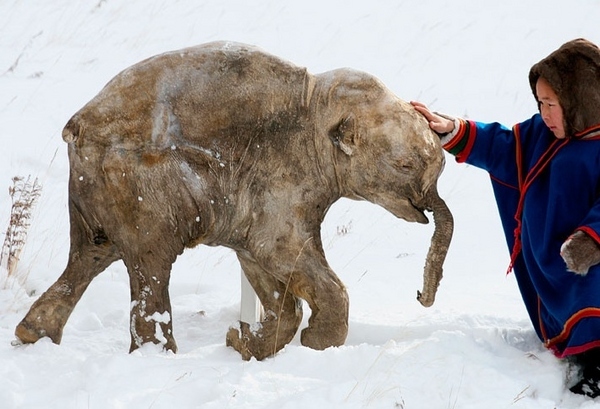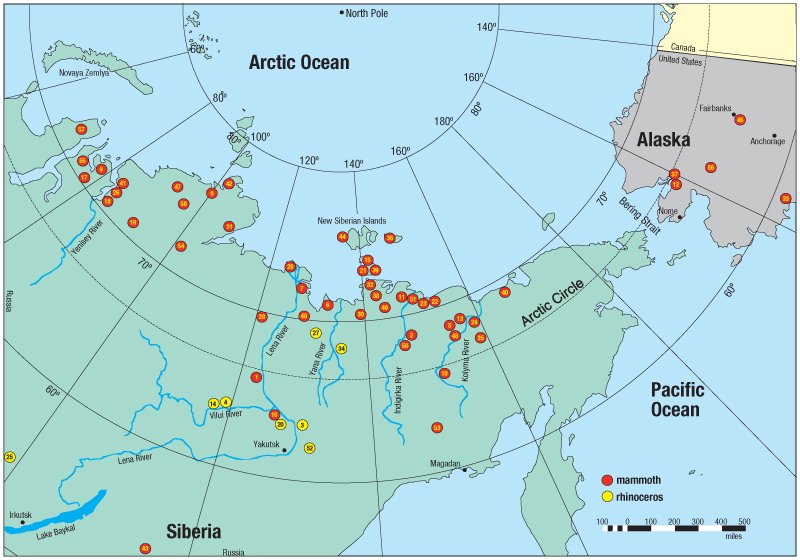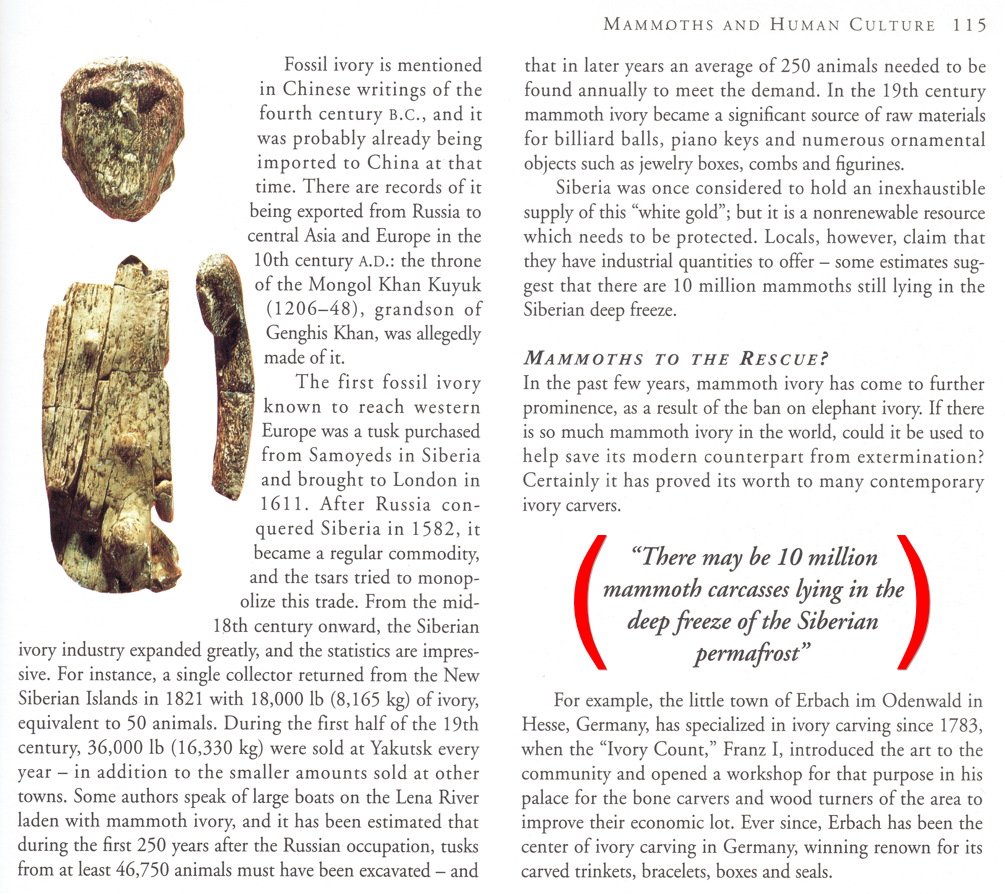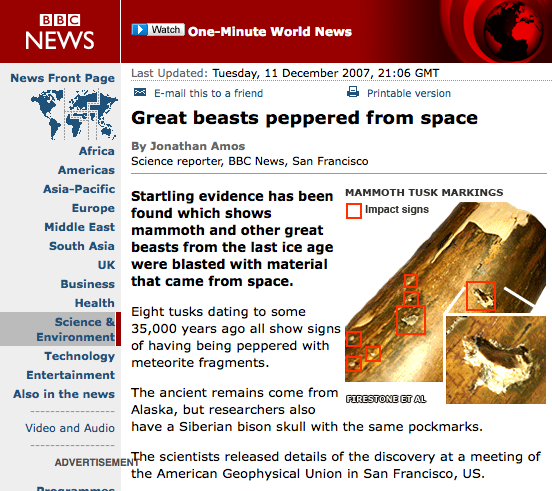 * Kevin Lea and Bob Enyart Discuss "Woolly" Mammoths: In this special edition of Real Science Radio, Kevin Lea, with his background in nuclear physics, talks with Bob about frozen mammoths. Pastor Lea of Calvary Church, Port Orchard Washington, describes the roll of the Earth which explains why we find remains of millions of mammoths (and horses, rhinos, etc.) in the arctic circle where they could not live because while each animal requires many gallons of liquid water and more than a hundred pounds of vegetation per day, the arctic has frozen surface water and gets almost no sunlight through it's long winter, when its scant vegetation is then completely dormant. And of course, woolly mammoths had no wool.
* Kevin Lea and Bob Enyart Discuss "Woolly" Mammoths: In this special edition of Real Science Radio, Kevin Lea, with his background in nuclear physics, talks with Bob about frozen mammoths. Pastor Lea of Calvary Church, Port Orchard Washington, describes the roll of the Earth which explains why we find remains of millions of mammoths (and horses, rhinos, etc.) in the arctic circle where they could not live because while each animal requires many gallons of liquid water and more than a hundred pounds of vegetation per day, the arctic has frozen surface water and gets almost no sunlight through it's long winter, when its scant vegetation is then completely dormant. And of course, woolly mammoths had no wool.
 Kevin and Bob, using as a guide Dr. Walt Brown's book In the Beginning, talk about the mammoths being buried in the arctic circle in rock ice, muck, and loess (this German term is pronounced there: lerse; here: less). The Bible records that the fountains of the great deep broke forth and flooded the Earth and, as it turns out, water that shot up to space but without escape velocity came back down as supercooled ice at colder than 150 degrees below zero, and froze mammoths so quickly the temperate climate vegetation in their stomachs were preserved! When time of death is estimated for the frozen mammoths, it lies in late summer or early fall, providing another piece of evidence against the hypothesis that each of these creatures died in unrelated events. And hear an amazing prediction, that beneath upright (and other undisturbed) mammoths, there is no layered strata, oil, coal seams, or limestone! Why not? Because these mammoths, frozen while still standing, were killed at the very beginning stages of the global flood and all those features are a result of that flood!
Kevin and Bob, using as a guide Dr. Walt Brown's book In the Beginning, talk about the mammoths being buried in the arctic circle in rock ice, muck, and loess (this German term is pronounced there: lerse; here: less). The Bible records that the fountains of the great deep broke forth and flooded the Earth and, as it turns out, water that shot up to space but without escape velocity came back down as supercooled ice at colder than 150 degrees below zero, and froze mammoths so quickly the temperate climate vegetation in their stomachs were preserved! When time of death is estimated for the frozen mammoths, it lies in late summer or early fall, providing another piece of evidence against the hypothesis that each of these creatures died in unrelated events. And hear an amazing prediction, that beneath upright (and other undisturbed) mammoths, there is no layered strata, oil, coal seams, or limestone! Why not? Because these mammoths, frozen while still standing, were killed at the very beginning stages of the global flood and all those features are a result of that flood!
* Post-show Updates:
* Tusks Hit with Meteorite Fragments: See below for the discovery of mammoth tusks that were hit with iron-nickel meteorite fragments.
* Debate Fact Checking: Popular atheist AronRa brought up mammoths in a debate with Bob Enyart as an example of creationists being unreliable, regarding the claimed burial of millions of mammoths and that their diet included tropical vegetation. Therefore RSR provides the following and plans to occasionally update this page with documentation on the numbers of mammoths buried and the types of vegetation that grew in their environment.
 * On the Number of Mammoths in the Arctic: See below, and also this quote from the Smithsonian magazine, John Massey Stewart (Dec. 1977, p. 68) referring to an estimate made by one of the world's leading experts on mammoths for a section along the Arctic coast between the Yana and Kolyma rivers:
* On the Number of Mammoths in the Arctic: See below, and also this quote from the Smithsonian magazine, John Massey Stewart (Dec. 1977, p. 68) referring to an estimate made by one of the world's leading experts on mammoths for a section along the Arctic coast between the Yana and Kolyma rivers:
Through such causes almost 50,000 mammoth tusks are said to have been found in Siberia between 1660 and 1915, serving an extensive mammoth ivory trade. But this is nothing compared to those still buried, according to Vereshchagin, who calculates that the heavy erosion of the Arctic coast spills thousands of tusks and tens of thousands of buried bones each year into the sea and that along the 600-mile coastal shallows between the Yana and Kolyma [rivers] lie more than half a million tons of mammoth tusks with another 150,000 tons in the bottom of the lakes of the coastal plain.
And in this peer-reviewed, Polar Record Cambridge journal article, The mammoth "cemeteries" of north-east Siberia:
The north of Yakutia [covering a minor portion of the Arctic] has long been known to be an immense storehouse of frozen disjointed bones of many hundreds of thousands of large Pleistocene mammals—mammoths, horses, woolly rhinoceroses, bison, musk-oxen... the quarrying of mammoth ivory has gone on for many centuries... the greatest interest lies in the discovery of whole frozen bodies... Study of the position of these bodies... and of the contents of their stomachs and intestines may answer the age-old question of why the mammoth (or woolly elephant), together with this rich assemblage of large herbivores, died out.
The estimate of ten million in permafrost is reported in the 1994 Macmillian book Mammoths, by Lister and Bahn on page 115:
* See Also: Walt Brown's fabulous chapter on Frozen Mammoths; the section in the RSR debate with atheist AronRa on mammoths (also pasted just below) and the fun show that Kevin Lea and Bob Enyart did on Comets!
From the RSR Debate with AronRa:
On Millions of Mammoth Remains in the Arctic, on Frozen Mammoths, and Tropical Seeds: [Aron's 7th of 9]: Aron brought up this topic on air as an example to my audience of how they can't trust what creationists say. He rejected my defense that the remains of millions of mammoths are known in the northern latitudes, saying, "there were 51 mammoths, not millions." He said that if we were having a written debate, we could actually document the evidence, so that the readers would know who was reliable. So, now that we are in that debate, it would have been nice of Aron to acknowledge that he was wrong about the number of mammoths. But instead, he dropped that error of his, and pressed these other disagreements:
- I challenged Bob to show that there were [n]ever any mammoths found frozen with tropical flora anywhere near them. … Bob also said mammoths could not possibly survive in the environments where millions of them are known to have lived and I refuted his claims about those conditions too."
Sigmund Freud would have enjoyed this segment of our radio debate (Part 5, just fast-forward to 15:30). Aron is bothered that he was mislead "since I was a little kid…" So here's how it actually went:
Aron: "There were 51 mammoths." Bob: "There are millions."
Aron: "I found that there were 51 mammoths, not millions. And that none of them, not one, was found with tropical flora in their mouths… so when you look into the data, if this were a written discussion…"
BE: "I've got the data. The tonnage of mammoth tusks, that were sold on the worldwide market, indicate that there were millions of mammoths that were buried in Siberia, and at the Arctic Circle, and north of the Arctic Circle. And there were mammoths that had the seeds of tropical plants, the seeds, in their digestive track."
Aron: Wrong.
Enyart: We'll, I could give you the data.
Aron: I challenge you.
Enyart: Do you think I'm wrong…
Aron: Yeah I do.
Enyart: …about [there being] over a million mammoths buried.
Aron: Yeah. Yeah, I definitely do. And it's a formal challenge.
Enyart: How about a $500 bet to your favorite charity, that the documentation shows that over a million mammoths have been buried?
Aron: With tropical flora in their mouths?
Enyart: No, no. There was just one like that.
So here is the documentation I promised.
New York Times, Trade in mammoth ivory… flourishes:
"The Siberian permafrost blankets millions of square kilometers… Hidden in one of the upper layers of this mass, corresponding to the Pleistocene epoch, are the remains of an estimated 150 million mammoths. Some are frozen whole, as if in suspended animation, others in bits and pieces of bone, tusk, tissue and wool."
Aron, this information had been in the Mammoth article on Wikipedia until I linked to it for our radio program, and then within 24 hours, one of our atheist RSR fans removed it. That's not a unique phenomenon. :)
Smithsonian publication: Frozen Mammoths from Siberia Bring the Ice Ages to Vivid Life:
"Nikolai Vereshchagin, Chairman of the Russian Academy of Science's Committee for the Study of Mammoths, estimated that more than half a million tons of mammoth tusks were buried along a 600-mile stretch of the Arctic coast. Because the typical tusk weighs 100 pounds, this implies that about 5 million mammoths lived in this small region." (p. 68, quoted by Walt Brown)
Creationists are excited about this data. But the hard scientific data that atheists prefer to ignore (just Google this stuff) includes millions of mammoths buried in permafrost, 14C everywhere, Grand Canyon nautiloids, and dinosaur soft tissue!
Dr. Walt Brown's map along with his Table 8 presents the locations and documentation for each of the 58 sites shown where frozen mammoth and rhinoceros remains have been discovered.


Just like 14C in diamonds, and tissue in dinosaurs, if you want to find buried mammoths in permafrost all you have to do is just go look.
Aron: No tropical plants near mammoths in Arctic. Bob: Yes there were.
In fact, there's a lot of tropical flora buried near the mammoths in the Arctic.
With earthquake expert and graduate of the U.S. Naval Nuclear Power program, Kevin Lea, we recently aired realscienceradio.com/mammoths. The following two references were part of our show prep, courtesy of Dr. Walt Brown:
Geophysical Research Letters:
"[Canada's Ellesmere Island, well inside the Arctic Circle, was] warm enough throughout the year to sustain palm trees and other tropical flora and fauna." Daniel B. Kirk-Davidoff et al., "On the Feedback of Stratospheric Clouds on Polar Climate", Vol. 29, 15 June 2002, p. 51.
Natural History:
"On eastern Axel Heiberg Island [in the Arctic Circle in Canada], ... fossil forests are found. ... just 680 miles from the North Pole. The stumps of ancient trees are still rooted in the soil and leaf litter where they once grew. ... many trees reaching more than a hundred feet in height." Jane E. Francis, "Arctic Eden,", Vol. 100, January 1991, pp. 57–58.
The strange loess hills that Siberian mammoths are often found in contain, "two and a half times the amount of carbon that's in all the world's tropical forests."
And in Alaska, where today the nearest forests are hundreds of miles away:
-
-
- "Though the ground is frozen for 1,900 feet down from the surface at Prudhoe Bay, everywhere the oil companies drilled around this area they discovered an ancient tropical forest. It was in frozen state, not in petrified state. It is between 1,100 and 1,700 feet down. There are palm trees, pine trees, and tropical foliage in great profusion. In fact, they found them lapped all over each other, just as though they had fallen in that position." -Lindsey Williams, The Energy Non-Crisis, Worth Publishing Co., 1980, p. 54 (quoted by Walt Brown)
-
The most well-studied frozen mammoth is Berezovka, with its mouth and tongue well preserved, and according to Nature, its "mouth was filled with grass, which had been cropped, but not chewed and swallowed." And the grass was frozen so quickly that, "it still had the imprint of the animals molars," wrote Lister and Bahn in Mammoths on page 46. However, its stomach contained three seeds from plants that produce delicate, yellow buttercups. Fragments of other flowers were in its stomach. No large flowers were in its mouth.
As summarized by Dr. Brown, "Its stomach contained three seeds from plants that produce delicate, yellow buttercups. Fragments of other flowers were in its stomach." Aron denied that these creatures would have frozen quickly, and he offers that one particular mammoth was buried while eating a tulip from Denmark. However unless frozen rapidly, vegetation would digest in an animal's stomach and intestines. And in all, "Twenty-four pounds of undigested vegetation were removed from Berezovka and analyzed by Russian scientist V. N. Sukachev. He identified more than 40 different species of plants: herbs, grasses, mosses, shrubs, and tree leaves. Many no longer grow that far north; others grow both in Siberia and as far south as Mexico."
Aron says that such mammoths were eventually buried when they fell into a hole, broke a leg, and froze to death in the cold. But, millions of them? In the Arctic? Aron denied that there were millions of mammoths in the Arctic, that any tropical flora were found near mammoths, and he denied my point that all those giant creatures would have a problem finding sufficient food and water, needing more than 100 gallons of liquid water a day each. Consider that a recent 150-pound, 7-foot tusk was found 110 miles north of the Arctic Circle where, today, for five months of the year the high temperature is lower than freezing, and for six months of the year the low is less than 0 degrees F. But during the ice age at those latitudes almost all year long it would have been a lot colder! These all didn't wander into pits; they died catastrophically. -END DEBATE EXCERPT-
 Alaska Update: A RSR listener in Fairbanks, Russ Holmes, called to alert us to the opening to the public in August 2012 of a 100-foot permafrost tunnel. Interestingly, in this tiny stretch of exposed sediment, a news photo documents a mammoth tusk protruding from the tunnel wall.
Alaska Update: A RSR listener in Fairbanks, Russ Holmes, called to alert us to the opening to the public in August 2012 of a 100-foot permafrost tunnel. Interestingly, in this tiny stretch of exposed sediment, a news photo documents a mammoth tusk protruding from the tunnel wall.
Best Mammoth Find in a Century: In October 2012, an 11-year-old boy walking a few miles from his home in norther Siberia came across the most well-preserved mammoth found since 1901. This find is said to have confirmed that the mammoth hump is not skeletal (which RSR believes should have been expected based on various previous finds). Rather, the mammoth hump is a fatty store similar to that of a camel. Not surprisingly, this has been interpreted as an adaption for surviving harsh arctic winters. Of course, if camels were known only from northern fossils, their hump would have been similarly and thus wrongly interpreted as an adaption to severe cold.
Of Interest: 2013 report from Alaska of a more recent, and more southern, forest thawing beneath retreating glacier ice.
* Research on Random Mammoth Tusks Show Meteorite Damage: At an American Geophysical Union conference, researchers from the Lawrence Berkeley National Laboratory explained that after they found evidence of meteorite explosions in high latitudes, they decided to use a magnet in the examination of a couple thousand mammoth tusks (out of millions known to exist). Amazingly, they found eight! The magnet initially helped them identify the eight tusks that had suffered iron-nickel meteoritic impacts...
Read more about this at the bbc.co.uk and on this page of Dr. Brown's In the Beginning book! * Stunning Information from Axel Heiberg & Ellesmere Islands: These barren tundra islands once supported burrowing animals including the badger and shrew, coldblooded animals including the snake, turtle, and alligator, and temperate vegetation and redwood trees! Interestingly, the oxygen absorbed by the growing trees had the common and lighter Oxygen 16 but lacked the heavier Oxygen 18 isotope. Question: Might this be explained by the breaking forth of the fountains of the great deep as explained by the Hydroplate Theory with their sea of free neutrons flowing through the subterranean chamber? [Exercise for the student: Please find and email to Bob@rsr.org references for badger, shrew, and snake fossils on these islands.]
* Stunning Information from Axel Heiberg & Ellesmere Islands: These barren tundra islands once supported burrowing animals including the badger and shrew, coldblooded animals including the snake, turtle, and alligator, and temperate vegetation and redwood trees! Interestingly, the oxygen absorbed by the growing trees had the common and lighter Oxygen 16 but lacked the heavier Oxygen 18 isotope. Question: Might this be explained by the breaking forth of the fountains of the great deep as explained by the Hydroplate Theory with their sea of free neutrons flowing through the subterranean chamber? [Exercise for the student: Please find and email to Bob@rsr.org references for badger, shrew, and snake fossils on these islands.]
* 2015 Update -- More Evidence of Mammoth Suffocation Deaths: See Michael Oard's paper Evidence some wolly mammoths asphyxiated from dust.
* Other Great Kevin Lea Shows on Real Science Radio: Enjoy Kevin Lea, hydroplate expert, on the origin of comets, liquefaction, and even the 365-day year.
* Personhood: The most important human rights movement of your lifetime. Will you be one who fights to end the systematic dehumanization and murder of an entire class of citizen? If you live in any state in America, you can advance personhood via the 2010 ballot or in one of three different ways. If you live in Colorado join by calling or e-mailing Colorado Right to Life.
Today’s Resource: You can enjoy one or two of Bob Enyart’s entertaining and insightful videos each month, downloaded or mailed to you automatically, simply by subscribing to the BEL Monthly Topical Videos service! Also, you can check out the other great BEL subscription services or get full years of our RSR shows downloadable or on single mp3-CDs. Just go to store.kgov.com or call us at 1-800-8Enyart (836-9278).


